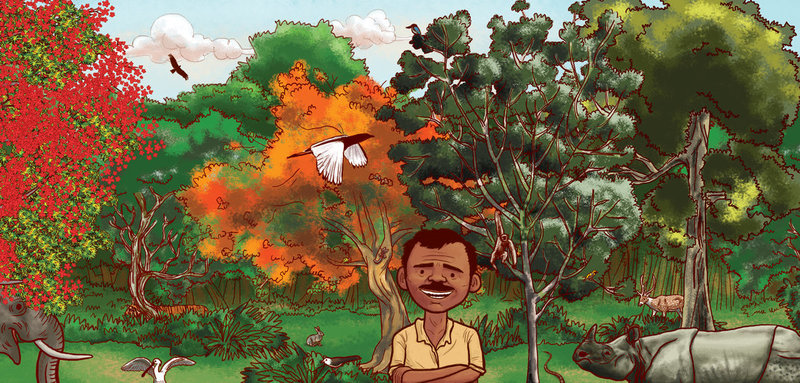Vinayak Varma on illustrating picture books
Posted by Remya Padmadas on August 14, 2017Vinayak Varma is an illustrator, writer and editor based in Bangalore. He is the author of 'Angry Akku', 'Jadav and the Tree-Place' (Pratham Books) and 'Up Down' (Tulika Books), and was the founder editor of Brainwave magazine. His articles and short stories have been published in The New Indian Express, DNA, Deccan Herald, The Hindu, Muse India and Out of Print Magazine, and he has illustrated books for Penguin, Harper Collins, Hachette, Scholastic, Duckbill and Pratham Books. You can visit Vinayak online at www.mixtape.in, instagram.com/mixtape.in and twitter.com/eyefry.

Vinayak is judging the 'Who is Ameena?' contest and shares some insights on illustrating for children's books for those of you planning to enter.
To start off with, here's a general overview of the process that I (and most other illustrators) follow:
1. Once I receive the brief for a book, I first try to identify a set of visual criteria that will work best for it:
- A governing style -- if I want to try something entirely new, which is different from the way I've drawn before, I create a mood board with a bunch of reference illustrations from various sources (Pinterest works particularly well for this purpose), and I try and spend some time at a good children's book store (like Lightroom in Bangalore) for some inspiration;
- The medium -- I decide what art materials I should use, how much of it should be traditional media, and how much can be digital, etc.;
- Visual research -- if I'm drawing an animal, for instance, I'll need photo references of that animal in various angles and poses. Similarly, for landscapes, buildings, flora, etc.
2. I then sketch character designs for the central protagonist(s) in the book. I do multiple iterations in several styles, so that I have varied options from which to choose.
3. Next, I make thumbnail drawings for all the illustrations -- these are very rough, and meant only to indicate the overall composition of each illustration. Along with these, I make one detailed drawing, as a proof of what the rest of the book will look like.
4. I then submit all these to the art director or editor I'm working with, for their approval.
5. Once approvals come in, and pending any corrections, I make detailed pencil sketches of all the pages (based on the thumbnails I already made), ink these drawings, and go ahead with the final colouring.
A few general tips and tricks:
-- You can build consistency in your artwork (and pose a fun creative challenge for yourself) by defining a very specific colour palette, and drastically limiting the number of inking and colouring tools you use. Visual consistency also comes from creating a strong internal logic for your style of illustration, and sticking to it. For example, some artists choose to draw characters' eyes as little black dots, some draw white circles with black dots, some draw them in the shape of large pomfrets, and some draw anatomically correct eyes. Similarly, there are the artists who draw buildings, landscapes and objects with perfect perspective and clean lines, while others may use a more impressionistic approach. What you choose to do in any of these instances is entirely up to you, but once you've made your choice, you need to stand by it for the rest of the book.
-- Your art should add a whole new dimension to the story. Instead of merely repeating what the text says, allow your illustrations to take creative liberties, and add interesting details that go beyond what the writer has suggested. Remember that picture books always have two authors -- both the writer and the illustrator are creative equals in this medium, working in tandem but with distinct viewpoints -- so don't be shy of exerting your unique authorial and artistic vision.
-- Having fun while illustrating is important, of course, but it might also benefit your artwork to imagine that this might be your last and greatest work, and that everyone is going to judge the hell out of you based on how well this turns out. I often use this strategy to frighten myself into delivering (I hope) a somewhat-above-average product. And it works for the most part -- except when I allow the fear to paralyse me into a state of deep inertia... Hmm. On second thoughts, maybe this isn't the best advice in the world. Yeah, okay, forget I said anything. Just do that 'having fun' part.
In summary: look at lots of picture books before starting out, make strong artistic choices, take plenty of creative risks, and have fun.
For more details on 'The Who is Ameena?' contest and to enter, click here.